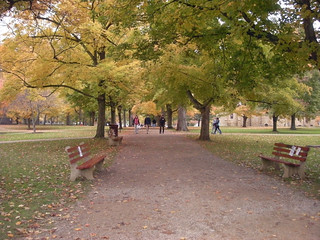Kenyon’s Middle Path is a mile-long stretch of gravel running through the center of the college. Given time, almost everyone at Kenyon walks Middle Path; it’s not just an pedestrian artery, but arguably the heart of the campus, the place where we see each other, communicate, nurture relationships.
We also joke that it’s a terrible route if you actually have work to do, since you’re likely to leave your office to attend to one job, and get snagged by two or three more people needing your attention.
I thought about Middle Path when I read this quote:
Care workers function as a human loom, shuttling from one home to another, stitching the social fabric back together while many of their employers and shareholders, and government ministers, slash blindly at the cloth… – George Monbiot
It’s not my intention to take on the whole of Monbiot’s argument about inequality, though I think it’s worthy of consideration. Nor do I want to directly compare home health workers to teachers and instructional technologists. I was struck by the metaphor of the “human loom”, and that’s what I’d like to reflect upon.
It’s easy to think of our jobs as primarily existing in their discrete locations – teaching a class, working on a project. These may be the places where we’re most aware of using our specialized skills. When someone asks “what did you do today?”, these are the stories which are easy to tell. In that construction, shuttling back and forth seems like friction, like overhead.
The shuttle, though, actually does its work by moving, and maybe we do too. It’s incumbent on us to think about the whole “social fabric” as we move from task to task – looking for the opportunities to connect people where our departments or disciplines or institutions have separated them. Particularly at small institutions, academic support staff like instructional technologists and librarians sit in wonderfully interdisciplinary positions for encouraging these conversations. We may know who’s interested in particular pedagogies or scholarly themes, and it’s within our power to get some of these people together, at least to share information and become aware that they are not alone.
Within our professions too, there are wonderful small communities which allow people to connect across institutions. And I would be remiss if I didn’t thank some of my professional contacts, friends and mentors, who have modeled these socially connecting behaviors for me, and who I now rather consciously ape.

We should also consider Monbiot’s quote more directly in context. Can we mend those parts of the academic world which are not merely imperfect, but actually broken? Most specifically, I’m thinking here of the adjunct crisis.
Even if we don’t have much power to push for permanent or at least full-time hires, I submit that there are things we can do as individuals to make short-term members of our institutions feel more part of our community. We can be conscious about inviting them to professional development opportunities. (And it’s probably important to make sure some of those events are social, so they can connect with peers better than they might at a traditional “workshop.”) We can make an extra effort to help them get oriented – to our services and to the institution generally. And as April barrels into May and graduation and the end of contracts, we can make sure people get the support they need to exit our communities well. We can stay in touch.
“Life is made up of meetings and partings,” as a wise frog once said (and I’m surprised to find it’s not an actual Dickens line). Perhaps we should be paying as much attention to those events, little or big, as we do to the stuff which we believe is in between.
Image Credits:
1) Larry Miller, “K
2) Gerald McDermot, cover of “Anansi the Spider”, borrowed from http://www.picturebooksreview.com/2013/01/anansi-1972.html

 Lani Guinier’s new book
Lani Guinier’s new book 

![Zen [Explored]](https://live.staticflickr.com/3059/2775740314_e0217ceebb_n.jpg)












